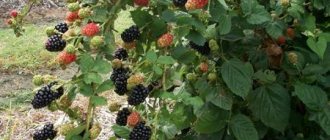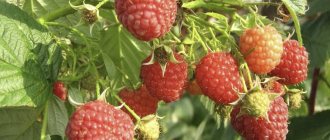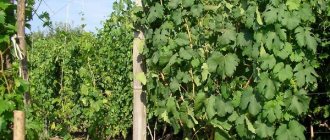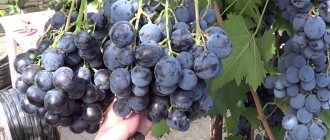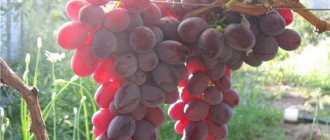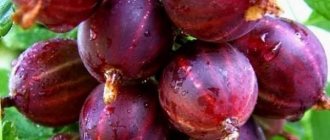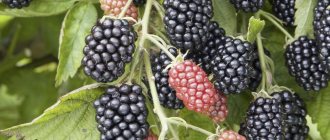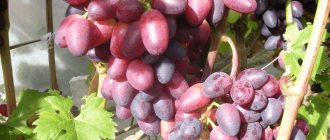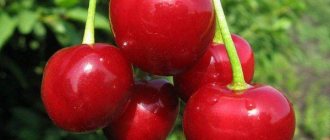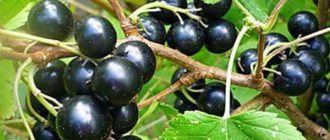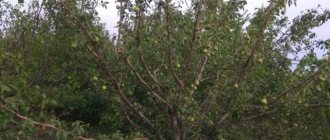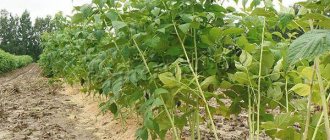A brief excursion into history
The Navajo blackberry variety has been around for over twenty years. It was bred in 1987 by American breeders from the University of Arkansas together with other blackberry species, the common characteristic of which is that there are no thorns on the vines. The name "Navaho" comes from the name of the Indian people. Mother plants: 'Thornfree', 'Cherokee'. Currently, the Navajo blackberry variety is popular not only in the USA, but also in Europe, as well as among Russian gardeners.
Reviews
I like the variety for its straight shoots and amazing berries with a wine-grape taste and rich aroma. I am slowly moving away from creeping blackberry varieties, because... “fussing” with them is many times more. The lashes grow 5-7 meters long, either wind them on a trellis or pull them out in one row. As for the Navajo, prune yourself following the example of raspberries, you don’t even need to make a trellis, the branches are thick and hold on that way.
When purchasing, do not get confused and do not make a mistake. There are 2 varieties of Navajo, there is simply Navajo, which is from the USA and bred at the popular Arkansas Institute, and there is Navajo Biganderly, which is from Europe and bred at the Lubera nursery. These are 2 completely different varieties and the description of Navajo Biganderly does not even indicate that the parent form is the Navajo variety. I think this is some kind of scam. I bought Navajo Biganderly without even thinking that it was something else, and waited for the declared miracle berries with an amazing sugary taste, but what I got was a rather mediocre harvest of sour berries. Be careful, nowadays they even try to deceive gardeners; they have found the rich.
Navajo blackberry: variety description and characteristics
Navajo blackberry: video
Blackberries are a subgenus of the Raspberry genus. The subgenus has eight varieties, two of which are cultivated. Blackberry is a subshrub with flexible vertically growing or creeping vines. The crop is grown for its fruits, which have a sweet or sweet-sour taste, resembling raspberries in appearance, but blackberries are not red, but dark blue or black.
General characteristics.
Navajo blackberry is a robust bush; shoots are vertical, grow up to two meters. They are quite powerful, but can bend due to the large number of fruits; for this reason, a garter is required after the shoots reach one and a half meters or more. The shoot-forming ability is high, therefore, a large number of shoots are formed.
In addition to the classic Navajo blackberry, there is also a hybrid variety that was obtained from it - Navajo Bigandearly. This species is not a full-fledged variety, which differs from the source in its characteristics, but a hybrid. Manufacturers claim that the hybrid grows vines that are higher in height (up to two and a half meters) than the shoots of the usual Navajo blackberry variety, and also say that the ripening of the fruits of the hybrid occurs faster, and the berries have a dessert taste. This is also suggested by the name of the hybrid form, which translates as “large and early.”
Fruit.
The fruits are shortened, conical in appearance, even in size and appearance, quite small (if compared with other types of blackberries) in size. The average weight is four to seven grams. The bush compensates for this trait with a large number of fruits that ripen on one bush. For example, one mature blackberry can contain more than half a thousand fruits.
Navajo blackberries are dark blue in color (at technical ripeness - bright black), glossy, and have an excellent, moderately sweet taste. Tasting score – 4.9 b/5 b, and most gardeners consider the taste almost a standard. The fruits retain their taste and appearance for five days. The grains are small, almost impossible to notice, and this is another advantage of the variety; blackberry lovers appreciate it. The fruits are plump and therefore have good transportability.
Growing and care
With high-quality planting, in the 2nd year you will be able to enjoy blackberries. Shrub care is simple:
- Weeding and loosening, in the case of laying mulch in the root zone of the bush, is required to be minimal.
- Watering is needed only in the absence of precipitation during the formation and ripening of fruits. In addition, if the autumn is dry, abundant moisture-recharging watering is carried out, which will protect the plant’s root system from frost.
- Pruning the bush increases resistance to diseases (improves ventilation) and stimulates photosynthesis, which improves the quality of the crop. The Navajo blackberry variety tends to thicken - pruning is a necessary measure. At the end of spring, when young shoots reach a height of 1 m, their tops are pinched to enhance the growth of side shoots. After harvesting, it is mandatory to remove fruit-bearing branches. For fruiting, 3-4 replacement shoots are left, the remaining branches are removed.
- Navajo produces good yields even without additional fertilizing, but if available, the yield can be even higher, and the berries will be larger. For the first 2-3 years, the plant needs enough nutrients added to the holes during planting; in addition, the mulch rots over time and gradually nourishes the plant. Starting from the 3rd year of the bush’s life, urea is added to each bush in the spring at the rate of 20-30 g per plant, and potassium salts (25-35 g) in the summer. Once every 3-4 years, the bushes are fed generously with rotted manure (up to 5 buckets for each bush).
- Preparing a blackberry bush for winter begins with pruning. The bush removed from the supports is tied with twine and bent to the ground. If you fill it with dry leaves or spruce branches and cover it with burlap, the plant will calmly withstand 30-degree frost. Under such shelter and fallen snow, the plant overwinters even in the harsh conditions of Siberia and the foothills of the Urals.
Features of Navajo blackberries
Navajo blackberry: photo
The Navajo blackberry variety has characteristics that attract the attention of a wide variety of gardeners with varying degrees of blackberry growing experience. In this regard, it is increasingly being chosen for cultivation on their territories by Russian summer residents.
Main advantages.
Navajo blackberries are an undemanding variety and do not require any special care. It has good tolerance to dry periods, is able to grow on almost any soil (but likes to grow on sandy and loamy soils filled with nutrients), has good resistance to frosty periods (down to minus twenty degrees), therefore in areas where temperature conditions decrease in winter year occurs at least -20 degrees, it does not need to be covered. In other regions, the bush will need shelter. The shoots do not have thorns, which means that picking berries by hand will be much easier.
Navajo blackberries: ripening dates
Navajo blackberries ripen late, which means they bloom later; in mid-Russian latitudes, flowers appear from the 15th of June. Fruit ripening, as indicated in the description, occurs in August or September. This is influenced by the weather of a certain time of year, the well-being of the bushes themselves and, to some extent, the planting site (in a well-lit or shady area).
Productivity, fruiting.
Due to the many fruits, the yield rate is quite high - nine kg / one square. The bush bears fruit over a long period of time - three to four weeks.
Where are Navajo blackberries used?
For the most part, the berries are eaten fresh, but they are also used for winter storage. The fruits are used to make compote, jam, preserves, stuff pies with them, and use them for freezing.
Immunity to diseases and resistance to attacks by harmful insects.
It has been noticed that the Navajo blackberry variety does not get sick, and harmful insects do not attack it, therefore, there is no need to treat the bushes with pesticides if there is no need. In this regard, the waste of time, money and effort that a summer resident would spend on cultivating blackberries is reduced.
Advantages and disadvantages.
Pros.
- The variety is self-fertile (no pollinating assistants are needed for the ovaries to form).
- A decent yield indicator, since the fruits are produced in large quantities.
- Unpretentiousness to growing conditions.
- Easy to care for (since the shoots are vertical).
- You can easily pick the fruits because there are no thorns and the berries are in large clusters.
- The fruits are well preserved and transported (even though the berries are juicy, they retain their elasticity and do not spread for almost seven days after they were picked).
- Excellent dessert taste of berries.
disadvantages . Gardeners say that with increased humidity and in the summer season with cool temperature conditions, the yield indicator becomes lower; the taste of the fruit is affected by the radiation of heat and light that the bushes absorbed. Another disadvantage is that it is necessary to cut off excess vines that thicken the plants.
Botanical description
Navajo blackberries have the following characteristics:
- The weight of the fruit is 7 g, but berries weighing 5 g are more common;
- The absence of thorns on the bushes, as a result of which the process of collecting fruits is simplified;
- The taste of the berries is sweet, no tartness;
- The structure of the pulp is dense and juicy, painted in a characteristic black color;
- The berries are cone-shaped;
- Productivity is high - up to 7 kg of fruits per bush;
- Good resistance to transportation.
Navajo blackberry: variety propagation
Navajo blackberry: photo
Reproduction of Navajo blackberries is carried out using basal suckers, and the apical parts of the shoots also take root. The procedure is easy: when the young shoot reaches sixty cm, its apical parts are cut off. Then new lashes begin to grow from the leaf sinuses. Together with the shoot, they bend down to the ground and dig a little deeper. In the autumn season or the next spring season, they are dug up, cut off from the mother bush and transplanted to a new area. The basal shoots, when they reach twenty cm, are dug out along with a lump of earth and transplanted to new places.
Reproduction
Even a novice gardener can cope with propagating Navajo blackberries. Using the vegetative method, you can quickly (within 1 season) obtain many cuttings for planting in a permanent place.
| Methods | Description |
| Root suckers | Young growth up to 20 cm in height (“nettle”) is dug up along with a lump of earth and transplanted to a new place throughout the season. |
| "Chinese" method of rooting tops | The young shoot, upon reaching a height of 60...70 cm, is pinched. when the side shoots begin to grow, the branch is pinned to the ground and a small mound of soil is poured on top - about 7...10 cm. By autumn, the layering takes root. It is better to leave it over the winter, in connection with the mother plant, and separate it next spring. |
In this simple way, even from one single seedling, it is quite possible to grow a plantation of Navajo blackberries - for preparing a variety of winter preparations or consuming delicious berries fresh.
Navajo blackberry: planting
If you properly care for the shrub, it will grow and bear fruit well within ten to fifteen years; this is largely influenced by where and how the planting was carried out. That is why planting and agricultural technology in the spring play a big role for the further development of blackberries and their yield.
Optimal time.
The recommended time for planting Navajo blackberries is the spring season; in the north, planting can be done in the first days of summer. Blackberries are not planted in the autumn season, because young bushes have poor tolerance to the winter period, especially long and harsh ones.
How to choose a suitable site.
The site for planting Navajo blackberries is selected to be well-lit by the sun and warm, however, a semi-shaded place is also allowed. It is forbidden to plant blackberries in the shade, since there will always be a lack of light and heat, because of this the fruits will be small and have a sour taste. You can plant bushes on an open plain or on a small hill, next to fences, outbuildings, it is important that there is protection from strong gusts of wind and drafts.
How to prepare the soil.
The plant is not picky about the type of soil, but the quality of the soil must be at a high level. It must necessarily be filled with nutrients, humus, light, loose, breathable and with a neutral level of acidity (a slightly elevated one is possible). Blackberries prefer moist soil, but not waterlogged, because excessively high humidity is prohibited, since in damp soil the root system can rot.
Preparation of the site for planting is carried out in the autumn or spring seasons. For this purpose, it is cleared of vegetation residues, dug up, and organic substances or minerals are added. A couple of days before planting, the soil is leveled with a rake and planting holes are dug.
How to select and prepare seedlings.
Choose seedlings that are healthy, undamaged, not affected by diseases, and well developed. They should have a strong root system and powerful shoots with green leaves. Planting material with dried roots or poorly growing vines is not suitable for planting. Before planting the bushes, the roots are moistened and placed in a solution of the Kornevin preparation to stimulate root formation. They are kept there for as long as indicated in the instructions.
Progress of planting work.
The interval between seedlings is at least one and a half to two meters. Planting holes should have a large volume: diameter and depth - sixty cm. When planting, humus (one bucket) and ash (two tablespoons) are poured into each hole. The top dressing is covered with a soil layer to prevent the roots from coming into contact with it.
Landing algorithm.
- The soil in the hole is moistened.
- The bush is installed in the center, the roots are straightened.
- The seedling is covered with soil to the level of the growth buds.
- The shoots are cut off, leaving two or three buds on each.
- The surface soil layer is mulched. For this purpose, hay, sawdust, straw or non-acidic peat are used.
- Place a strong trellis near each bush, and tie elongated lashes to it. Another method: supports are installed along the borders of the row, and between them a wire is stretched in two or three rows to support the bushes.
Further agricultural technology.
Caring for the variety is very simple. If planting is done correctly, then next year expect the first fruits to appear, and in the fourth year the bush will give a generous harvest. The main goal of the gardener during this period of time is to provide the blackberries with the required amount of water and fertilizing, to form bushes and prepare them for the winter season.
Landing nuances
Navajo blackberries are undemanding to care, but they still need to be planted according to all the rules. If you choose the most suitable place and apply fertilizer when planting, the plant will reward its owners with fragrant berries every year.
Choosing a place
When choosing the location of blackberries on a plot, gardeners should be guided by some cultural features. Blackberries are light-loving plants, so it is recommended to choose a sunny place for them. It also grows well in partial shade, but with a lack of sunlight, the berries will become smaller and the shoots will stretch out.
It is recommended to plant blackberries in a row in a sunny place.
It should also be taken into account that the crop does not tolerate excessively wet soil. Where blackberries are planted, the groundwater depth must be at least 1 m, otherwise the plant may simply die. Blackberries are considered a non-winter-hardy crop. The area for planting seedlings should be well protected from sharp gusts of wind from all sides.
Planting blackberries
Unlike other crops that are recommended to be planted in the fall, blackberry seedlings are best planted in early spring so that the above-ground part of young plants does not freeze in winter. Experienced gardeners advise planting blackberries in a row along the border of the site, retreating 1.5 m from the fence. A distance of 1 m should be left between plants in the line, since the Navajo variety has a greater ability to form shoots.
Pits for planting blackberries are prepared 2 weeks before the expected date
The holes for seedlings are prepared 2 weeks before the expected planting date. They dig holes approximately 40 cm deep and wide. A nutrient substrate (top fertile layer of soil mixed with humus or compost and mineral fertilizers) is placed at the bottom. Soil without fertilizers is poured onto it so that the roots of the seedlings do not “burn out”.
Step-by-step instructions for planting blackberries
- Moisten the soil in the pre-prepared planting hole.
- Place the seedling in the middle and straighten the roots.
- Sprinkle the root system with soil so that the growth bud located at the base of the main shoot is buried no more than 2–3 cm. If you deepen it, the beginning of fruiting may be delayed by a year.
The growth bud should be buried 2–3 cm
- Make holes around the seedlings, moisten and mulch with humus or rotted sawdust.
- Blackberries produce a lot of growth and can overrun nearby areas in a short time, so planting must be limited by digging slate sheets along the row, and this must be done not only from the side of your site, but also next to the fence.
- Near each bush, drive a peg to which you will later tie long blackberry shoots. Or make a trellis by digging posts along the sides of the row and stretching two rows of wire at a height of 50 cm and 1 m from the ground.
Blackberry shoots are tall, so they need support
Navajo blackberries: variety care
Navajo blackberry: photo
Gartering of bushes is desirable, despite the fact that the variety is not tall. The bushes are grown on supports, but an alternative is to use special pruning of the main and side branches.
Agrotechnical practices.
Agricultural technology is standard: water, loosen (or mulch), weed the soil. Watering is carried out abundantly, especially during flowering and when berries are forming. You cannot overwater, because blackberries will not tolerate overly moist soil. If the area where the bush grows is small, then you can build a drip irrigation system. Thanks to it there will be an even distribution of water and its saving. After the rains have passed or watering has been carried out, the soil is loosened, weeds are weeded, or the soil is mulched to prevent it from drying out quickly. Moisture-recharging irrigation is carried out provided that the autumn season is dry.
Circumcision procedure.
Navajo blackberries form a lot of shoots, for this reason they are pruned from the 2nd year of development. Late in spring, the apical parts of young vines that have grown up to one meter are cut off. Because of this, side shoots begin to grow, the volume of the bush increases, and more fruits are produced.
Navajo blackberries continue to be formed in the autumn season, because the fruits are formed on the shoots of the previous year, producing a harvest for only one season. Therefore, they must be cut out. Pruning is carried out in the autumn season, the shoots are cut to the very root. You only need to leave three or four new lashes and shorten them.
Navajo Blackberries: Preparing for Winter
Navajo blackberry bushes provide shelter for the winter. For this purpose, the shoots, after the leaves have fallen from them, are removed from the support, tied together and bent to the ground. The top is covered with agrofibre or spruce branches. Under such protective material, the bushes will definitely be safe, frosts will not affect them.
Diseases and pests
There are a number of diseases and pests that must be dealt with immediately, otherwise the blackberry bushes will die. The following are the most common diseases and pests, and measures to combat them.
- With septoria and powdery mildew, the main signs of the disease are brown or gray spots on the leaves. Bordeaux mixture should be used as a medicinal preparation - it should be used to irrigate the bushes before flowering and after harvesting.
- With anthracnose, red spots appear on the foliage, and it begins to dry out and fall off. In order to cure this disease, it is necessary to irrigate the plant itself and the soil with the drug “Skor”, in a proportion of 20 ml per 10 liters of water - before flowering and after the formation of fruits.
- If a whitish coating appears on the plant, this means that the plant is infected with ashtray . After winter, the bushes must be irrigated with warm water, and during the process of ovary formation, sprayed with Oxychom, Vectra, and Fundazol.
- When a spider mite , small beetles are visible on the leaves, and the bushes themselves begin to turn yellow and dry out. When such a pest appears, it is necessary to treat the plants with a tincture of tobacco, onion peel or garlic with the addition of 100 g of laundry soap. Repeat the procedure every 7 days.
- The raspberry beetle is a parasite that infects leaf blades by eating holes on them. To combat it, it is recommended to treat the leaves with Actellik or Fufanon (instructions for preparing the solution are indicated on the packages). Spray every 10 days.
Navajo blackberries: reviews from gardeners
Valeria, 29 years old, Tomsk region: “I got the Navajo blackberry variety not so long ago. Despite the fact that the fruits are not so large, the fruiting is abundant, and therefore the overall harvest is quite decent. I liked the fact that the Navajo blackberry bushes are thornless, making it easy to care for and collect fruits without scratching your hands.”
Valentin, 37 years old, Stavropol Territory: “I purchased the Navajo blackberry variety for its productivity, ease of cultivation, immunity to diseases, and the fact that it is very easy to care for the bush. When picking fruits, a large number of black berries are removed from the bush, which are distinguished by their excellent taste and incredible aroma. I advise everyone involved in gardening and anyone interested in blackberries to cultivate Navajo blackberries.”
Osage blackberry: planting
Osage blackberry: photo
The blackberry bush is not that demanding of care; even novice gardeners can grow it. Before being satisfied with a decent harvest, proper planting of blackberries is required.
For this purpose, it is necessary to select a suitable site, purchase high-quality planting material and prepare the soil for planting.
Optimal time.
The variety is planted in the spring after the snow melts. The soil should warm up well, temperature conditions should be positive and stable, and there should be no cold snaps at night.
How to choose a site for planting.
Osage blackberries feel comfortable on loamy soils with a neutral reaction; they will not grow on acidic soils. The area should be well lit and warmed by sunlight, but at the same time protected from cold winds.
Groundwater should lie one meter below the surface soil layer. The soil is freed from weeds and their roots, thoroughly dug up, if necessary, fertilizing is applied and the soil acidity level is corrected.
How to select and prepare seedlings.
To grow healthy blackberries with generous yields, you need to carefully select planting material.
High-quality seedlings must be one year old, they must have two powerful shoots, reaching two cm in diameter, the roots must also be well developed, and there must be a bud on them.
It is recommended to purchase planting material from specialized nurseries. Seedlings must be intact, have smooth skin and a flexible stem.
How to plant.
Before planting begins, a soil mixture is prepared to fill the planting holes. For this purpose, the soil is mixed with humus, and potassium and phosphorus are added. Clay soil is diluted with peat and sand.
Algorithm.
- Inspecting the roots, removing damaged areas, trimming very elongated roots. When the root system dries out, it is soaked in a solution of the root formation preparation.
- A hole is dug 1.5-2 shovels deep.
- 2 handfuls of soil mixture are poured into each hole, watered, and wait for the liquid to be absorbed.
- Two seedlings are positioned straight, the roots are straightened.
- Next, the planting material is covered with soil, and the soil is compacted.
- The root collar is buried three to five cm.
- A ditch is constructed and filled with water (ten liters per bush).
- Mulching is done with straw, peat, sawdust.
- The seedlings are pruned, leaving twenty cm of length.
Preparing and caring for bushes in winter
Blackberries are not very frost-resistant and preparing the plant for winter is of great importance. The berries of this crop are formed on the shoots of the previous year, and freezing of the upper part of the bush leads to a lack of harvest.
Before the cold weather, shoots that have been bearing fruit for two years are removed. Unnecessary new branches are removed. To avoid excessive stretching of the bushes in height, you should pinch the upper parts of the stems. This action will allow the shoots on the sides to develop and gain strength. Old stems are cut off at the root so that pests can settle on them.
To avoid the spread of parasites, cut branches should be burned along with the debris. After treatment, sawdust or peat is poured under the bushes, which provides the plant with moisture and protects the root system from freezing. All varieties of blackberries, including frost-resistant ones, need shelter for the winter. Sometimes the soil near the bushes is covered with roofing felt, corn leaves or hay.
Ripe Navajo blackberries
Features of planting and growing
To plant thornless blackberries, you need lighted and well-warmed areas in the sun.
Such bushes are best grown in areas protected from the winds. For favorable cultivation of berries, fertile soil varieties and soil moisture are required. Care should be taken to ensure that the roots of the plant do not become wet. Excess moisture negatively affects the development of shrubs and reduces the quality and volume of the harvest. Limestone content in the soil leads to leaf disease.
Thornless blackberries are planted in spring or late autumn. The choice of time of year depends on the characteristics of the harvested varieties. Seedlings with high resistance to frost can be planted in autumn, and plants with reduced winter hardiness - in winter.
Before planting, the root system of seedlings is slightly shortened. Quite long root shoots are trimmed and spoiled and damaged parts are removed. The landing recess usually reaches fifty centimeters in depth. A mixture of humus and compost is added to the hole. Wood ash is sprinkled on top, and lime is mixed into the highly acidic soil.
A plant growing straight is placed in a row at intervals of one meter with a row spacing of up to two meters, and varieties spreading on the ground are separated in a row from each other with a spacing of up to four meters and a row spacing of about three meters. Seedlings carefully placed and well sprinkled in the holes are watered. To conveniently moisten the soil, a hole is created around each bush. The top of the soil is sprinkled with straw or sawdust.
Regular feeding of bushes leads to a rich harvest. Every year in the spring, the ground around the plant is fertilized with humus and ammonium nitrate. In summer, it is good to add diluted bird droppings or manure to the soil. In autumn, the soil is enriched with superphosphate and wood ash.
You may also be interested in the following articles about blackberries:
- Description of Agavam blackberries.
- Why are there a lot of flies on blackberries and what to do with them?
- Details about the Black Satin blackberry variety.
Growing thornless blackberries is not difficult. It is necessary to properly care for the bushes and monitor the condition of the plant. To create suitable conditions for the growth of shrubs it is necessary:
- regular saturation of the soil with moisture;
- removal of young shoots;
- thinning overgrown bushes;
- establishing support for gartering shoots;
- shrub formation;
- loosening the soil and removing weeds.
Landing
Young plants have a hard time withstanding winter: Navajo blackberries are not planted in the fall, the best time for planting is spring, and in the northern regions even the beginning of summer.
A blackberry bush can grow in one place for up to 10-15 years, so it is important to initially select a site that meets the requirements of the plant. The best place for planting a young blackberry bush is a sunny area at a distance of 1.5-2.0 m from a fence or building wall (protection from wind and drafts), slight shading is acceptable (the berries may become less sugary). High soil moisture is contraindicated for blackberries - excess moisture leads to rotting of the roots and death of the bush, therefore the depth of groundwater in the place where blackberries are planted should not be less than 1.0 m. The type of soil is not important - for blackberries it is important to grow on loose, fertile soil, well-seasoned organic. If we talk about optimal conditions, then these are sandy loam or loam with neutral or slightly increased acidity.
Before planting, prepare 1 bucket of humus and 1/2 liter of ash for each seedling. Fertilizers are added directly to the hole during planting, sprinkled with soil on top to prevent burns to the roots.
- The area for planting should be prepared in the fall - cleared of weed roots, dug up and filled with compost or humus at the rate of 10 kg/m2.
- Before planting, it is advisable to soak the roots of the seedlings overnight and treat them with a root formation stimulator such as Kornevin according to the instructions.
- Holes for planting are marked at a distance from each other of at least 1.5 m.
- The hole itself must be at least 60 cm in diameter and of similar depth.
- Humus, ash and a shovel of earth are added to the planting hole. All components are mixed and poured with water.
- The seedling is placed in a slight depth, its roots are straightened and covered with soil.
- After watering (at least 10 liters for each plant), the root zone is mulched, and the seedling is shortened to 2-3 buds.
Each bush is equipped with a support or trellis. Growing on a trellis increases yield and makes planting easier to care for.
Navajo can be accused of excessive shoot-forming ability, therefore, in order to avoid looking for young shoots in nearby beds, greenhouses, etc., it is advisable to dig in pieces of slate, iron or a special garden limiter along the borders of blackberry planting.
Characteristics of the variety
The Navajo blackberry variety is a perennial plant. The bushes form strong, straight shoots, each of which can reach up to one and a half meters in length. The berries are not particularly large (up to 4.5 g each), but their size does not affect the yield of the variety. From one mature bush you can collect up to 500 berries per season.
Benefits of Navajo blackberries include:
- high tasting score (from 4.5 to 5.0 in different periods);
- absence of thorns on the shoots, which greatly simplifies manual picking of berries;
- good yield with simple care;
- the ability of fruits to maintain their shape and density for 5 days, which allows them to be transported to places of sale.
The description and characteristics of Navajo blackberries cannot but affect its taste. The berries are juicy, sweet, with slight sourness and a pronounced blackberry aroma. They ripen in late summer or early autumn, each bush bears fruit for about 3 weeks.
Characteristic
The following will present the distinctive characteristics of the Navajo blackberry variety.
Drought resistance, frost resistance
The plant tolerates arid climates well. As for low temperatures, blackberries can withstand frosts (-20°C) without significant losses. In regions where the winter temperature drops below this figure, it is necessary to cover the bushes with organic material (spruce branches, vegetable tops, sawdust, burlap).
Find out what blackberries on your site are incompatible with.
Productivity, fruiting
The yield of this variety is quite high - it is possible to collect 9 kg of berries from 1 m² of plantings. Fruiting lasts from 3 to 4 weeks. In the first year after planting, you should not count on a high yield. High yield of fruits is observed only in the fourth year of the plant’s growing season.
Features of cultivation
As already noted, blackberries of this variety grow and bear fruit better in areas where there is a lot of heat and light. Partial shade is not an obstacle to fruiting and high yield, however, berries that have not received enough sunlight will grow less sweet and aromatic.
As an unpretentious plant, blackberries can grow in any soil, but to get a good harvest, it is better to plant the crop in light sandy loam or loamy soil, enriched with humus, and with neutral or slightly increased acidity. Too wet soil in a lowland or with a high groundwater level is not suitable for blackberries - waterlogging causes its root system to rot.
With proper care, a Navajo blackberry bush can bear fruit for 10–15 years, so you should approach the planting process as if you were planting a perennial fruit tree. The planting hole must have the appropriate dimensions: a diameter of 60 cm and a depth of at least 50 cm. A bucket of humus, a couple of glasses of ash, and 80–100 g of mineral fertilizers should be poured into the hole.
The most suitable time for planting blackberries is spring, but in the climate of the central zone the crop can be planted in early summer. The earlier the bush is planted, the more time it has to take root before the onset of constant cold weather. Autumn planting of seedlings is not practiced, since the crop has low winter hardiness.
Since the Navajo variety has erect stems, it can be planted in rows near a fence. If seedlings are planted in holes, then the distance between the bushes should be 1.5–2 m. The bushes of this blackberry are not tall plants, so you can do without installing trellises, but in this case it is necessary to trim the main shoots at the level of the side branches.
Fruit characteristics
Compared to other popular blackberry varieties, Navajo is not very large. The average weight of berries ranges from four to seven grams. However, the size is more than compensated by the quantity - there are indeed a lot of berries on the bushes, adult bushes produce more than five thousand berries per shoot.
The shape of the berry is a classic blackberry, a short, seemingly chopped off cone. The fruits are almost black in color, with a bluish, purple or burgundy tint. Seeds are present, but there are not very many of them, so they are practically invisible.
Tasters highly appreciate the taste of the berries of this variety - the pulp is dense and rich. Sweetness predominates, but a pleasant sourness is also felt. Another advantage is the aroma. The fruits have a very rich and pleasant blackberry smell.
On average, the harvest can be harvested in late September or early August - it’s hard to say more precisely, because the dates can vary quite a lot depending on the climatic conditions of a particular region. The easiest way is to just navigate by the berries. I harvest for about three weeks and during this time I have time to eat plenty of fresh berries and freeze them for the winter.
Landing rules
Planting and caring for Navajo blackberries is easy. This plant propagates by seedlings, which need to be purchased and placed in open ground. It is worth paying attention to the area for planting, since the bush, with proper care, lives for about 15 years. The requirements for this variety are simple:
- Blackberries prefer places that are not exposed to direct sunlight. It is better to choose a half-shaded area.
- The plant is unpretentious to the composition of the soil. However, the description of the Navajo blackberry variety states that the best yield can be obtained in sandy or loamy soils.
- When planting, it is worth considering that the bushes can grow quite large, so there should be at least 1.5 m between neighboring plants.
- Organic fertilizers (compost, humus) are placed in the planting hole so that the blackberries take root better. The plant is lowered carefully so as not to damage the roots, and then watered with water.
Navajo blackberries are planted in the spring. In warm southern regions it is possible to plant it in the fall, but the seedlings will definitely need to be covered for the winter.
Subtleties of care
Basic care for Navajo blackberries is no different from caring for other garden hybrids. On the contrary, given that this variety is characterized by erect stems, we can say that it is simpler, although it has its own subtleties:
- It is recommended to pinch (cut) young shoots not only in autumn, but also in early summer, when their height exceeds 1 m, while shortening the top by 20-25 cm, as well as side shoots - the procedure stimulates the growth of lateral branches, increases flowering and ovary formation ;
- for tying up plants, it is more convenient to use T-shaped trellises, but if the shoots are properly pruned and normalized, you can do without support;
- rationing of the bush is carried out in the fall according to the standard scheme, which assumes a remainder of 7–8 productive shoots per bush;
- Preparation for winter includes removing fruit-bearing old and underdeveloped young shoots at the root, removing branches from trellises, covering the bush with organic mulch, as well as insulating material.
Standard care measures include periodic watering 1–2 times/1 week, fertilizing, loosening the soil in the inter-rows and near-trunk circles. While the seedling is small, it is necessary to loosen the soil and remove weeds more often. When the bush grows, it is undesirable to loosen it around it, since if the integrity of the root system is damaged, shoots often appear, which grow and lead to thickening of the bush.
Blackberries are undemanding when it comes to fertilizing. As a rule, autumn mulching is enough for it, but for better growth and vegetation in the spring, you can apply 20–25 g of nitrogen fertilizer (urea, ammonium nitrate) under the bush, and 30 g of potassium during the ripening period of the berries. Once every 3–4 years, the bushes are fed in the spring with compost or humus in the amount of 4–6 buckets/1 adult bush.
Experienced gardeners who have dealt with growing Navajo blackberries claim that the cultivation technology of the crop is much easier than that of other garden varieties. The bushes practically do not get sick, are not damaged by pests, bloom profusely at the beginning of summer and are literally strewn with berries at the end of the season - in August.
Features of the variety "Loch Ness"
Surely every novice gardener who decides to plant this shrub wants to find a photo and description of the Loch Ness blackberry variety. Features of this variety include:
- berry picking is not extended (up to five weeks);
- The fruits ripen in August;
- shrub compact and semi-cresting;
- shoots four meters high, smooth, have no thorns;
- Loch Ness leaves are green, jagged;
- the berries are sweet, oval-shaped (weight - 5 grams), collected in multi-fruited tassels;
- the fruit seed is practically not noticeable.
As for the yield, it is very high, almost not inferior to other giant species. If the bush is more than three years old, then you will get about twenty-five kilograms of berries from the bush.
About the advantages and disadvantages of Loch Ness blackberries
When describing the Loch Ness blackberry variety, you should not forget to name the pros and cons of the plant. Of course, first you need to consider everything positive that the shrub has, and this is:
- one-dimensional, even fruits, excellent presentation;
- productivity at a high level;
- rapid reproduction;
- low maintenance requirements of the bush;
- Loch Ness is disease resistant;
- the bush can tolerate frost of 20 degrees;
- You can protect the bush from frost at your own discretion;
But the plant has two disadvantages so far. This is the sour taste of the berries when planted in the shade, and also the blackberries begin to ripen late. That is, the bush is demanding of light. In principle, compared to the advantages, the disadvantages of Loch Ness are scanty.
What should you consider when planting and caring for the Loch Ness bush?
I would like to note that all plants need proper care. If you abandon a bush, it will die as a result and you will not see a harvest. Therefore, if you decide to plant Loch Ness seedlings, then you need to know the important points:
- plant shrubs at a distance of three meters from each other;
- if blackberries are needed for sale, then reduce the distance between the bushes to two meters;
- use agrofabric to protect against weeds, drought and sunlight;
- When planting without using agrofabric, you need to use straw for mulch.
Of course, the Loch Ness blackberry bush will need to be tied up, propagated and pruned. As for the garter, it is needed, since the bushes create a trellis, the height of which is almost three meters. And it should not be more than the width of the blackberry rows. You will need to attach the bush vines to the wire in some way. There are mounting methods such as:
- circular weaving;
- zigzag weaving;
- fan weaving.
In order to propagate Loch Ness bushes, you only need to dig up their tops and then replant the young shoots. The main rule: before you start digging in and separating the tops with callus, do not prune the young vine, as these tops will not be able to take root.
Well, a few words need to be said about pruning Loch Ness. As for the lateral branching of the bush, it is good. While the shoots are shortened, they still continue to grow. Your job will be more difficult if you have dense plantings in your garden. To increase the volume of greenery on a bush, you can use the method of pinching side shoots. However, it will slightly delay the fruiting time.
Rules of care
Agricultural technology for Navajo blackberries is simple. If you planted the plant according to the recommendations, then the first berries will appear the next year, and in the fifth year the Navajo bushes will produce the largest harvest. The main tasks of the gardener when growing crops will be the formation of bushes, abundant watering and preparation for winter.
Hydration
Blackberries are drought-resistant plants, but they require moisture during flowering and when fruit sets. Under each bush you need to pour 10 liters of water if there is no rainfall during this period. Please note that blackberries cannot tolerate too much moisture.
Bush pruning
Blackberries very actively form shoots, which thicken the plantings and prevent the formation of berries. Because of this feature of the crop, bushes must begin to be pruned from the second year after planting. There are several ways to form blackberry bushes - the choice of which one to use depends on the location of the plantings and the preferences of the gardener.
Blackberries produce a lot of growth, so the bush must be pruned annually
Fan formation
Pruning is done in the fall. Cut out all the shoots in front and behind the bush. 3 fruiting shoots are left on the sides, and all the old ones are cut out in the middle, leaving 3-4 new stems.
Formation of landings with ropes
With this method, fruiting shoots are placed along the wire, and all stems that grow outside the row are cut out completely. 3-4 new shoots are left in the center of the bush.
Recent postsPlanting grapes in the fall as an alternative to spring: what are the benefits? Technology for pruning cherries in the fall: diagrams and instructions for beginnersBeautiful maple tree in landscape design: 60 photos of successful application ideas
Shaping by waves
Shoots with berries are directed in waves along the outer row, and young ones make up the second. After the end of fruiting, the first row is cut out completely, and the new shoots become fruiting branches for the next year.
Placing growing and fruiting shoots separately makes caring for plants and harvesting much easier.
Preparing for winter
Navajo blackberries are a cover crop. After the end of leaf fall, the shoots must be tied and bent to the ground. It is recommended to insulate them on top with spruce branches or special non-woven material.
Please note that blackberry shoots are quite fragile and can easily crack when bent to the ground.
Some gardeners advise laying blackberries on the ground along with a trellis. To do this, the columns are removed from the ground and placed along with the shoots. This method helps protect brittle stems from damage.
